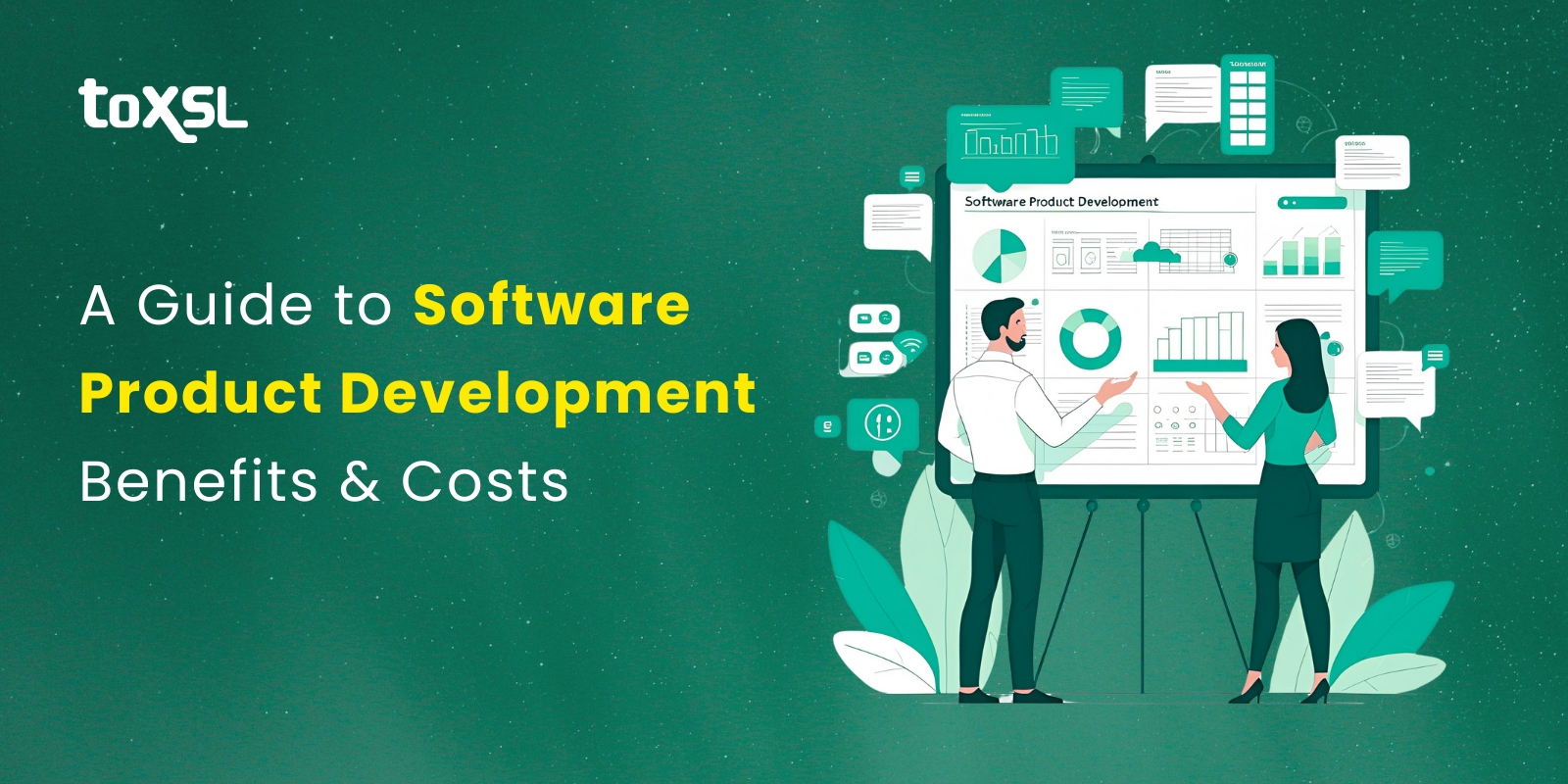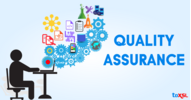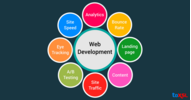- Sep 19, 2025
Share this post on:

The global population of software developers is expected to reach $128.7 million by 2025. 84.7 % of software development projects are based on enterprise automation and 53.6% on business automation. Further, by 2030, the custom software development market size is expected to reach $146.18 billion at a CAGR of 22.5%. Further, businesses investing in software development have reported 20% growth in revenue on average.
Software product development is the process of developing a new software product with unique or required functionalities and value. It may include developing or updating a product. Refining the system’s process, method, or development methodology.
Software developers develop solutions that work well with unique business needs. They incorporate third-party features and tools into the solutions, helping businesses enhance their services and revenue.
Key Takeaways
- Software product development enables businesses to scale, automate, and gain a competitive edge.
- Custom software offers full control, security, and improved efficiency.
- The development process includes idea validation, design, coding, testing, deployment, and maintenance.
- Development costs typically range from $10,000 to $100,000, depending on complexity and scope.
- Hiring the right developers involves evaluating skills, cultural fit, and offering competitive perks.
Benefits of Software Product Development
Software product development offers numerous advantages that can transform a business’s operations and market position:
Scalability and Flexibility: Custom software products are unique solutions customized to business requirements. Off-the-shelf software or SaaS (Software as a Service) products can not be customized as per business requirements. However, custom software products give the business full ownership and control over the application. This means that businesses can scale and upgrade their software at any time without waiting for a third party, allowing your business to grow flexibly and efficiently.
Optimized Business Processes: Custom software solutions can easily automate repetitive and time-consuming tasks. This frees up valuable time and resources, helping management focus on more strategic activities. Also, optimizing internal processes using customized software solutions reduces operational costs and improves overall efficiency.
Competitive Advantages: Custom software products offer businesses unique features and great user experiences. The features of tailored software are unique and perform better than off-the-shelf customer software. The customization makes custom software solutions a better choice over off-the-shelf.
Enhanced Communication: Product development software tools improve communication and collaboration among teams. Custom software allows teams to streamline communication, project management, and documentation. This leads to faster development cycles, reduces errors, and develops higher-quality product or software solutions.
Security and Maintenance: Custom software gives direct access to the codebase, allowing businesses to implement customized security measures. You can easily fix errors, andupdate features without waiting for the help of a third party, ensuring the software remains secure and up-to-date. Performing a regular SAST scan can also help identify potential vulnerabilities in your code, further strengthening your software’s security.
Market presence: Developing software products allows businesses to target new customer segments and expand their market presence. Software products can be made accessible across borders, helping businesses enhance their global presence and increase revenue.
Software Product Development Process
The journey towards developing software products involves various key stages. A few of them are as follows:
Idea Generation and Research: First, you think about what problem your software will solve or what new thing it will do. You also check if people want it and if similar products already exist. This helps you decide if your idea is worth pursuing.
Planning and Requirement Analysis: Next, you write down exactly what your software should do. You decide on the features, how it should look, and how long it will take to build. This plan helps everyone understand what to expect.
Designing: Designers create simple drawings or models of how the software will look and work. This helps you see the idea before it’s built and make changes early on.
Developing the Software: Developers start writing the code to make the software work. They usually work in small parts, testing as they go, so they can fix problems quickly. Many companies choose to hire nearshore developers at this stage to access skilled talent in similar time zones, which makes collaboration smoother and more efficient.
Testing and Quality Assurance: Before launching, the software is tested to find and fix bugs or errors. This ensures it works well and is easy to use.
Deployment: Once everything is ready, the software is released to users. You might also train your team or customers on how to use it.
Maintenance and Updates: After launch, you keep an eye on the software to fix any new issues and add improvements based on feedback.
Software Product Development: Cost
The cost of software product development varies widely depending on the project’s complexity, scope, and technology used. In general, the cost of developing software ranges between $10,000 to $100,000. It is important to understand the main cost factors to plan your budget effectively. Here are a few factors on which software product development cost depends:
Development Costs: This includes the salaries of software developers, designers, testers, and project managers. More complex products with advanced features, integrations, or customizations require more development time and thus higher costs.
Planning and Research: Market research, requirement analysis, and product design also add to the development cost. Investing in deep planning reduces risks and costly changes later in the development cycle.
Testing and Quality Assurance: Comprehensive testing is crucial for a reliable product. Costs here depend on the extent of testing required, including manual and automated testing efforts.
Infrastructure and Tools: Costs may include servers, cloud services, development tools, and third-party integrations, depending on the product. These infrastructure expenses differ based on the scale and requirements of the software.
Opportunity Costs and Time to Market: Developing custom software takes longer than adopting off-the-shelf solutions. The time spent on development is an investment that delays the product’s market availability but can pay off by delivering a superior, tailored solution.
How to hire the best software developers for your business?
Here are a few tips that are required while hiring the best software developers for your business:
Define Job Requirements: Specify the skills, and experience level whether you want to hire a junior or senior. What type of working style (independent or team player) is needed for the role?
Technology Stack: Know what project the developer will work on and the technologies they must be familiar with.
Look Beyond Resumes: Don’t rely on academic degrees or resumes. Consider self-taught developers and practical skills.
Take Coding Tests: Give candidates coding challenges or real problems to solve that reflect actual job tasks.
Conduct Technical Assessments: Include coding tests, whiteboard challenges, and technical questions about tools, languages, and frameworks.
Check for Culture Fit: Assess communication, teamwork, adaptability, and alignment with company values.
Offer Competitive Salary: Research the market on salary and offer fair compensation salary. Also, offer perks like flexible hours or remote work.
Build a Talent Pipeline: Maintain relationships with potential candidates for future openings to reduce hiring time.
Final Words
Building your software product is a smart move if you want to build a customized product that fits your business perfectly. Customized products help you work better and keep you ahead of competitors. By understanding the benefits, the steps involved, and the costs, you can make informed decisions and develop software that truly helps your business grow.
If you’re ready to start your software journey, contact us today. We at ToXSL Technologies help businesses develop software that helps them generate better revenue. Request a quote today.
FAQS
1. How long does it take to develop custom software?
The development timeline depends on the scope and complexity of the project. A simple application may take 2–4 months, while a mid-sized project could require 6–8 months. Large-scale or enterprise-level software with advanced features and integrations may take 12 months or more. The time frame also includes planning, design, development, testing, deployment, and post-launch support.
2. How much does software product development cost?
Custom software development typically costs between $10,000 and $100,000 or more. The total cost is influenced by several factors, including the complexity of features, the technology stack, developer experience, UI/UX design, testing requirements, and ongoing maintenance. A detailed consultation and project estimation help in setting a realistic and optimized budget.
3. Can custom software be updated and scaled in the future?
Absolutely. One of the major advantages of custom software is that it can be continuously improved. As your business grows or changes, you can scale the software by adding new features, upgrading infrastructure, or integrating advanced technologies. This ensures your software remains relevant and continues to support your operations long-term.
4. How do I ensure that my software is secure?
Security is crucial in custom software development. To ensure safety, your development team should follow secure coding practices, use data encryption, implement strong authentication mechanisms, conduct regular code audits, and stay compliant with relevant data protection regulations. Regular updates and patches also help protect against emerging threats.
5. Do I own the software developed for my business?
Yes, when you hire a team for custom development, you typically own full rights to the software, including the source code, designs, documentation, and intellectual property. This gives you complete freedom to modify, license, or scale your software as needed without relying on third-party providers or paying recurring licensing fees.












